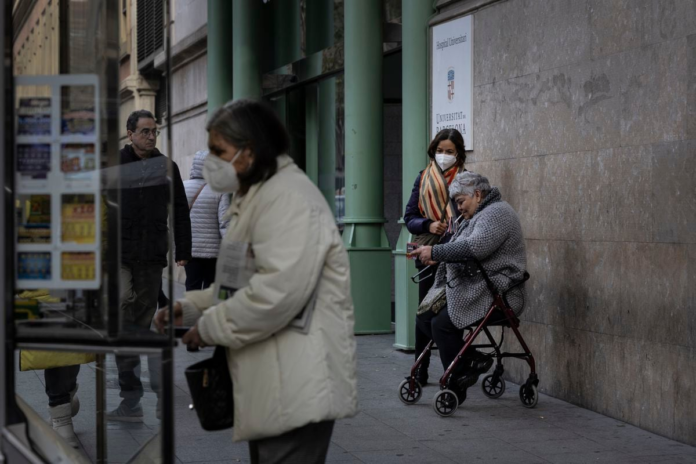Health centers are unable to cope with seasonal epidemics of respiratory viruses. In late 2023, after several seasons of unusual behavior caused by the coronavirus, the flu returned. It has also joined the ranks of coronavirus, which, although less impactful and virulent, has seen consultations collapse due to high patient demand and depleted staff over the Christmas holidays. Lorenzo Armenteros, spokesman for the Spanish Society of General Practitioners and Family Doctors (SEMG), concluded: “Outpatient emergency (outpatient) care is completely saturated.”
The latest epidemiological data released by the Carlos III Health Institute are from the week before Christmas Eve. By then, the number of notifications of acute respiratory infections in primary care had increased by more than 100 points: from 806 to 916 cases per 100,000 inhabitants. Everything indicates that in the following days, as the celebrations progressed, the family gatherings in between continued to grow strongly. New data will be released on Thursday, but experts expect infections to continue to rise in the coming weeks, with a peak expected in the second half of January.
doctor shortage
While these winter waves are predictable, history repeats itself every year, with greater or lesser impact on health centers, and the pandemic has exposed chronic shortages of professionals with no sign of resolution. The Department of Health admitted in a report a year ago that there were 1,000 fewer family doctors than in 2018. In May, semFYC submitted another report guaranteeing that 10,000 professionals would be allowed in over the next four years to replace incoming GPs. Retirement, which seems very difficult, since the conditions and salaries offered by the Autonomous Regional Health Center force many professionals to work in hospitals or abroad.
Entrance to the Abrantes Health Center in Madrid’s Carabanchel neighborhood on Wednesday. Marshal(EFE)
In Malaga, where Leovigildo Ginel, a member of the Spanish Association of Primary Care Physicians (Semergen), serves, this Christmas they broke the record for walk-in patients: 178 patients in a single day. Four doctors at work also joined their agenda. “More than 60 or 70 percent of people are coming in for the same thing: respiratory symptoms,” Ginell said. Most are influenza, which is twice as common as the coronavirus. Both are combined with other pathogens that have similar symptoms but are often unrecognized.
In most health centers, tests will not be carried out to distinguish what the virus is, which is reserved for so-called “sentinels” whose job it is to measure the impact of the epidemic on the country. Regardless of the virus, treatment will not be different for people without underlying medical conditions. Good hydration and paracetamol can relieve discomfort. This is what doctors usually recommend, in addition to taking precautions to avoid infecting susceptible people.
Amenteros therefore calls on people who are not at risk not to go to health centers at the first symptoms: people over 80 years old, or people with comorbidities or immunosuppression. “There is no need to be afraid. You should allow 48 hours to see how the symptoms develop, and take low-dose antipyretics or anti-inflammatory drugs to see how things go. If there is no improvement after this time, no medical assistance is needed; “It should be Save for more serious symptoms such as difficulty breathing (suffocating feeling), fever lasting more than four days, exacerbation of respiratory illness, change in mucus color…”, Amenteros lists.
One of the problems many patients face is that they need a medical certificate to prove their sick leave. “We have a very strong service industry here, but teleworking is not possible. The ideal situation would be like what other countries do and what we have been asking for some time: the patients themselves responsibly declare that their sick leave does not exceed three or four days. days. This will prevent saturation of medical centers to a certain extent,” Ginelle claimed.
The pair left the Abrantes primary care center in Madrid on Wednesday. Marshal(EFE)
Armenteros believes this flu wave could have been mitigated if vaccination rates had been higher and there had been more monitoring of the safety measures society had taken during the pandemic, such as the use of masks and air filtration systems. Figures for Spain’s national vaccination campaign are not yet clear; the health ministry will release them at the end of the season. But Armanteros believes that despite the first mass immunization campaign in 2023 for children under five, coverage has been “low”, especially among children who have the most reported cases.
This was backed up by data provided by Catalonia on Tuesday, with only 46% of the region’s population aged over 60 having received a shot, against a target of 75%. In the Valencian community, Health Minister Marciano Gómez called on people to get vaccinated and also announced that they were considering reinstating the mandatory wearing of masks in health centers in light of rising infections.
Are we facing a worse pandemic than in previous years?
The main virus circulating this season is influenza A, which often leaves more severe symptoms than other variants. But it remains a well-known pathogen. Judging from the data released so far, the situation faced by Spain is not special.
José María Eiros Bouza, director of the National Influenza Center in Valladolid, explained last week that “we are witnessing a common situation” at this time of year in the northern hemisphere. “Influenza is an infectious disease that occurs in the fall and winter and is associated with weather conditions and overcrowding. As a message to people who may be infected, people who are healthy, have no underlying conditions, and can tolerate it without having to go to the health system, and healthy It’s different for people with fragile conditions or elderly people.”
The latter often requires hospitalization due to respiratory viruses. Revenues are growing, but the situation in hospitals is a far cry from health centers. Antoni Torres, member of the Spanish Society of Pulmonology and Thoracic Surgery (SEPAR) in the field of respiratory infections, stressed that the collapse occurred in primary care because the vast majority of patients were not serious. “There has been some revenue, but it is still very little. We will see the data after the epidemic is over. There is still serious overcrowding and infection,” he concluded.
Subscribe to continue reading Reading without limits
_




